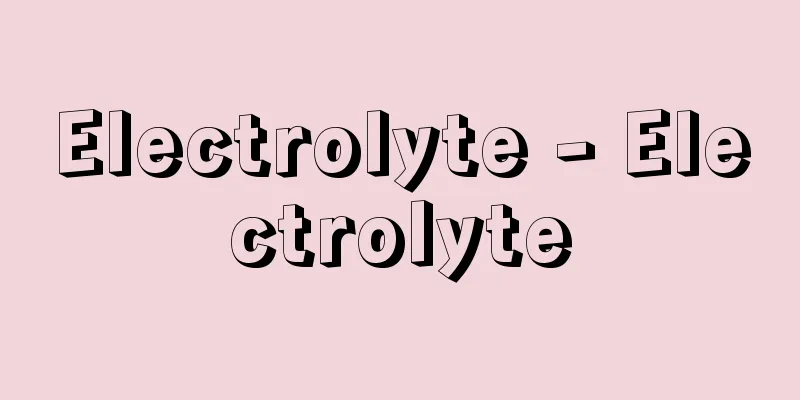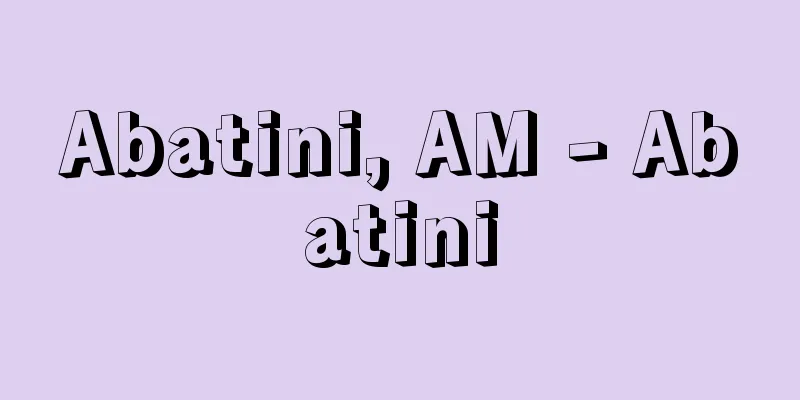Electrolyte - Electrolyte

|
A substance that dissociates into ions (called ionization) when dissolved in a polar solvent such as water, resulting in a solution with high electrical conductivity, is called an electrolyte. When electrodes are placed in an electrolytic solution and an electric current is passed through it at an appropriate voltage, the component ions of the electrolyte lose their charge and precipitate at both electrodes. This phenomenon is called electrolysis or electrolysis, and the name electrolyte is derived from this phenomenon. [Takashi Shimozawa] Ionization theoryThe presence of ions in electrolyte solutions was pointed out long ago by Faraday in England and Kohlrausch in Germany. To explain the measured values of heat of neutralization and electrical conductivity for aqueous solutions of acids and bases, the Swedish Arrhenius proposed that an ionization equilibrium is established between undissociated solute molecules and ions generated by ionization in these solutions. This was proposed in 1887 as the ionization theory, which states that "electrolyte solutions always ionize into free ions at a constant degree of ionization even without the application of an electric field." It is also called the Arrhenius theory or ion theory. This idea explains the phenomenon of electrolysis, as well as the fact that osmotic pressure, boiling point elevation, freezing point depression, etc. in electrolyte solutions appear to be greater than expected from the molar concentration. The flaw in the ionization theory is that it assumes that ions are in solution independently of each other and ignores the electrostatic interaction between ions. Furthermore, this theory was developed into a quantitative form by F. W. Ostwald and Nernst in Germany. [Takashi Shimozawa] Causes of ionizationElectrolyte salts such as sodium chloride (NaCl) exist as ions in both the solid and molten state. The dissociation of these electrolytes into ions in polar solvents is mainly due to the electrostatic attraction between the ions being weakened by the high dielectric constant of the solvent. In contrast, molecules such as hydrogen chloride (HCl) are covalently bonded under normal conditions and have low ionic bonding, but they dissolve in polar solvents and form ions. HCl+H 2 O―→H 3 O + +Cl - [Takashi Shimozawa] Strong and Weak ElectrolytesElectrolytes are classified into various types according to the type and properties of their constituent ions. Suppose a neutral molecule consisting of m positive ions with a valence of i and n negative ions with a valence of j undergoes the following ionization: A m B n m A i + + n B j - Electrolyte salts are generally strong electrolytes, and acids and bases show various degrees of ionization ranging from strong acids and bases to weak acids and bases. [Takashi Shimozawa] Ionization degreeThe ratio of the number of ionized ions to the total number of electrolytes is called the degree of ionization α. α is a number between 0 and 1, with strong electrolytes closer to 1 and weak electrolytes closer to 0. α also changes depending on the concentration and temperature. In other words, the lower the concentration and the higher the temperature, the larger the value of α. Even for weak electrolytes, α approaches 1 when the concentration is sufficiently dilute. α can be experimentally determined by measuring the van't Hoff coefficient i or electrical conductivity. For example, i can be determined from measurements of vapor pressure depression, boiling point elevation, osmotic pressure, etc., and α can be calculated using the following formula. α=( i −1)/( m + n −1) [Takashi Shimozawa] Relationship between degree of ionization and concentrationAs an electrolyte solution is diluted, the degree of ionization gradually increases. Ionization equilibrium is established between the non-ionized electrolyte molecules and the ionized ions, and the law of mass action applies. The law that expresses the relationship between this dilution degree (concentration) and the degree of ionization is the Ostwald dilution law (also simply called the dilution law). The ionization constant K of the ionization equilibrium is given by K = α 2 c /(1-α), but by using the dilution degree v (the reciprocal of the molar concentration c ), the Ostwald dilution rate K v can be obtained. K v = α 2 /(1-α) [Takashi Shimozawa] Strong electrolyte abnormalitiesIn the case of strong electrolyte solutions or highly concentrated electrolyte solutions, the law of mass action using concentration c cannot be applied (this is called the strong electrolyte anomaly), and Kc is no longer a constant with respect to changes in concentration. For this reason, effective concentration is introduced instead of concentration c . Now, let a be the activity and f be the activity coefficient, and let a = fc . When this a is used instead of c , the ionization constant becomes constant with respect to concentration, and the law of mass action is maintained. This idea was proposed by the American G.N. Lewis (1908). On the other hand, Debye of the Netherlands and Hückel of Germany explained the properties of strong electrolyte solutions from a completely different perspective. That is, they assumed that strong electrolyte solutions are completely ionized in dilute solutions, and believed that the deviation of measured values from theoretical values was due to electrostatic interactions between ions caused by ionization. In other words, they considered the solvent to be a uniform dielectric, focused on a single ion, and calculated the charge distribution around it. Next, they assumed that the electrostatic potential generated by this follows a Maxwell-Boltzmann distribution, and defined the osmotic pressure coefficient g in the strong electrolyte solution. g has the following relationship with K , α, c , etc.
[Takashi Shimozawa] "Solution Chemistry of Electrolytes" edited by the Chemical Society of Japan (1984, Society Publishing Center)" ▽ "Hydration of Ions by Hitoshi Otaki (1990, Kyoritsu Shuppan)" ▽ "Essential Electrochemistry by Reita Tamamushi and Katsuo Takahashi (2000, Tokyo Kagaku Dojin)" [References] | | | |©Shogakukan "> Dissolution of electrolytes and non-electrolytes in water Source: Shogakukan Encyclopedia Nipponica About Encyclopedia Nipponica Information | Legend |
|
水などの極性溶媒に溶かしたとき、イオンに解離して(これを電離という)、その溶液が高い電気伝導性をもつようになる物質を電解質という。 電解質溶液electrolytic solutionに電極を入れ、適当な電圧のもとで電流を通じると、電解質の成分イオンが電荷を失って両極に析出する現象を電気分解あるいは電解というが、電解質の名はこの現象に由来している。 [下沢 隆] 電離説電解質溶液にイオンが存在していることは、イギリスのファラデーやドイツのコールラウシュらによって古くから指摘されていた。酸や塩基の水溶液についての中和熱や電気伝導度の測定値を説明するために、スウェーデンのアレニウスは、これらの水溶液中で未解離の溶質分子と、電離によって生じたイオンとの間に電離平衡が成立すると考えた。これが「電解質溶液は、電場をかけなくてもつねに一定の電離度で自由なイオンに電離している」という電離説で1887年に提出された。アレニウスの説あるいはイオン説ともいう。この考えによれば、電気分解の現象も、また電解質溶液における浸透圧、沸点上昇、凝固点降下などがモル濃度から期待される値より大きく現れることも説明される。電離説の欠陥は、イオンは互いに無関係に溶液中にあるとし、イオン間の静電相互作用を無視したことである。さらに、この理論は、ドイツのF・W・オストワルトやネルンストらによって定量的な形に展開された。 [下沢 隆] 電離のおこる原因塩化ナトリウムNaClのような電解質塩類は、固体および溶融状態においても、その構成原子がイオンとして存在している。この種の電解質が極性溶媒中でイオンに解離しているのは、主としてイオン間の静電引力が溶媒の高い誘電率によって弱められることに起因している。これに対して、塩化水素HClのような分子は、普通の条件のもとでは共有結合の状態にあり、イオン結合性は小さいが、極性溶媒には溶けて、イオンを生成する。 HCl+H2O―→H3O++Cl- [下沢 隆] 強電解質と弱電解質電解質は、その構成イオンの種類や性質によって、さまざまに分類される。i価の正イオンm個とj価の負イオンn個からなる中性分子が次の電離を行うとする。 AmBnmAi++nBj- 電解質塩類は一般に強電解質で、酸や塩基は強酸、強塩基から弱酸、弱塩基にわたってさまざまな電離度を示す。 [下沢 隆] 電離度電解質総数に対する電離したイオンの数との比を電離度αという。αは0から1までの数字で、強電解質は1に近く、弱電解質は0に近い。またαは、濃度や温度によっても変化する。すなわち、濃度が低くなるほど、温度が上昇するほどαの値は大きくなる。 弱電解質でも、濃度が十分希薄になるとαは1に近づく。実験的にαはファント・ホッフ係数iの測定や電気伝導度の測定から求められる。たとえば、蒸気圧降下、沸点上昇、浸透圧などの測定からiを求め、次式によってαを求める。 α=(i-1)/(m+n-1) [下沢 隆] 電離度と濃度の関係電解質溶液を希釈していくと、電離度がしだいに大きくなる。電離しない電解質分子と電離したイオンとの間に電離平衡が成立し、質量作用の法則が適用される。この希釈度(濃度)と電離度の関係を表した法則がオストワルトの希釈律(単に希釈律ともいう)である。電離平衡の電離定数KはK=α2c/(1-α)で与えられるが、希釈度v(モル濃度cの逆数)を用いると、オストワルトの希釈率Kvが得られる。 Kv=α2/(1-α) [下沢 隆] 強電解質の異常強電解質の溶液や、高濃度の電解質溶液の場合、濃度cを用いた型の質量作用の法則の適用ができなくなり(これを強電解質の異常という)、Kcが濃度変化に対し定数でなくなる。このため濃度cのかわりに、有効濃度を導入する。いま、aを活動度、fを活量係数として、a=fcとする。cのかわりにこのaを用いると、電離定数が濃度に対して一定となり、質量作用の法則が保たれる。この考えは、アメリカのG・N・ルイスによって提唱された(1908)。 一方、オランダのデバイとドイツのヒュッケルは、まったく別の観点から強電解質溶液の性質を説明した。すなわち、強電解質溶液が希薄溶液では完全に電離していると仮定し、測定値の理論値からのずれは電離により生じたイオン間の静電相互作用によるものと考えた。すなわち、溶媒を均一な誘電体と考え、ある1個のイオンに着目し、その周辺の電荷分布を求める。つぎに、これにより生ずる静電ポテンシャルがマクスウェル‐ボルツマンの分布をしているとして、強電解質溶液内の浸透圧係数gを定義する。gはK、α、cなどと次の関係がある。
[下沢 隆] 『日本化学会編『電解質の溶液化学』(1984・学会出版センター)』▽『大滝仁志著『イオンの水和』(1990・共立出版)』▽『玉虫伶太・高橋勝緒著『エッセンシャル電気化学』(2000・東京化学同人)』 [参照項目] | | | |©Shogakukan"> 電解質と非電解質の水への溶解 出典 小学館 日本大百科全書(ニッポニカ)日本大百科全書(ニッポニカ)について 情報 | 凡例 |
Recommend
East India Party
A political organization in the Dutch East Indies ...
Manzai - Manzai
A humorous, light-hearted dialogue style in the e...
Jamunapari
...They have a milk production capacity of 600-12...
Echigo Mountains
A mountain range that runs northeast-southwest al...
Struwwelpeter (English spelling)
He is the poster boy, so to speak, for educational...
Rhys Davids, TW (English spelling) RhysDavidsTW
...In other areas such as philosophy and narrativ...
EPROM - Electronic read only memory
A rewritable read-only memory. Erasable ROM; abbre...
Nagayoshi Asano
...After the downfall of the Asakura clan in 1573...
Housework - Kaji
〘noun〙① Matters within the household. Private affa...
Sending wolf - Sending wolf
...When a wild boar or deer jumps out of the moun...
Kikai - Machine
〘Noun〙① A word that likens the air surrounding the...
Lawson cypress
...Benihi (red cypress) C. formosensis Matsum. gr...
Thermocolor
…A paint whose pigment is a compound that changes...
Announcer - announcer (English spelling)
In a broad sense, it includes people who make ann...
Inertial Confinement System
… [Methods of controlled nuclear fusion] In order...









